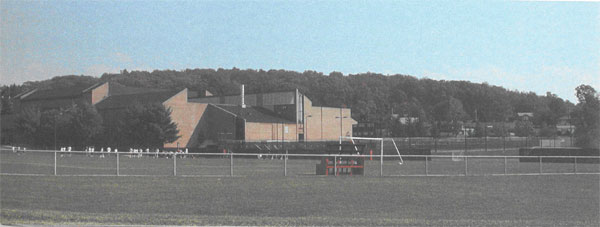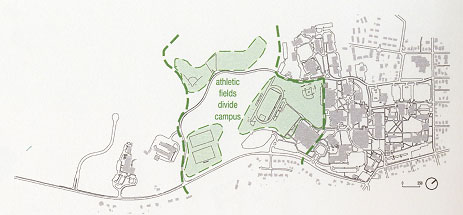









Frostburg State University
Frostburg, Maryland
As part of a team under the direction of Kling, the architectural firm completing a campus-wide facilities master plan for the University, Mr. Esposito and Mr. Fellingham assessed the existing 104,773 NASF, 168,732 GSF indoor and outdoor athletic, physical education, and recreation facilities of this Division III university relative to current and planned programs. They reviewed plans of the University for a new 60,000 GSF Recreation Center in light of projected enrollment, campus-wide changes in facility occupancy and function, and the impact on the existing Physical Education Center. Based on our needs assessment, ICAC recommended a renovation of the existing Center and a possible 29,200 NASF, 44,920 GSF building addition with a three-court multi-purpose gymnasia and elevated track to accommodate 10-year planning needs without the construction of the proposed, but not student approved, Recreation Center. In addition, ICAC recommended the demolition of the existing Press Box and construction of one that is ADA compliant and that provides appropriate sight lines and comfortable, weatherized seating for media representatives and University guests.
Specifically, the Physical Education Complex required renovation to bring it to an acceptable level of standard for use and to capture vacated space as other capital projects proceed. The overall building efficiency is expected to be reduced to 60% as additional public rest rooms, pre-function and queuing space, and display space are provided. While the core athletic facilities are retained, the renovation project calls for the complete renovation of all locker rooms, training room, team rooms, a new administrative office suite for Athletics, and appropriately sized offices and support spaces for coaches. Skylights should be added for natural lighting. An elevated track could be provided above the Multi-purpose Gym/Rooms, if the optional addition is not included as part of the project. Glass walls should be provided for the handball and squash courts and lounges with snack bars should be provided, all to increase socialization and recreation opportunities for students. The entire building infrastructure systems also require upgrading.
ICAC identified that the baseball field had a major drainage issue, which could be addressed by renovation of the existing field or installation of an artificial surface field. If an artificial surface field were installed, this outdoor facility could then be used by the Field Hockey team as its main field in the fall term. Upper fields (football practice, field hockey, women's lacrosse, intramurals, and rugby) must be reconditioned and regraded. The topsoil is too thin, causing rocks and shale to surface which must be viewed as both safety and liability issues.

Frostburg State University Physical Education Complex
Mr. Esposito and Dr. Linhart were also responsible for the facilities needs assessment and capital project recommendations for all the remaining academic and administrative units of the University and assisting Kling in completion of the Facilities Master Plan. The existing campus consisted of 42 buildings, 800,216 NASF, 1,319,011 GSF, and their overall facility recommendations called for:
-
Demolition of 5 buildings-65,275 NASF, 109,168 GSF,
- Relocation and renovation of 1 building-6,639 NASF, 8,580 GSF,
- Construction of 3 buildings-115,920 NASF, 212,585 GSF,
- Renovation and addition to 5 buildings-244,474 NASF, 407,198 GSF (renovated) and 171,982 NASF, 302,463 GSF (new), and
- Renovation of 10 buildings-121,647 NASF, 227,300 GSF.

Frostburg State University Athletic Fields Campus Development Issue
Rejecting the strategies of leapfrogging-developing the campus in the large, undeveloped portion of the campus-and displacement-relocating the athletic fields to the undeveloped portion of the campus and replacing the vacated space with campus development, the University choose an infill strategy that maintained the pedestrian campus core and identity, reduced parking demand, reduced infrastructure and development costs, and maintained existing athletic field locations.
<< Back To Projects